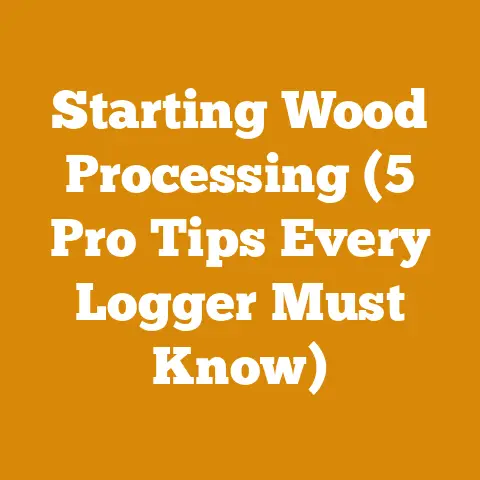Stihl Backpack Brush Cutter: Ultimate Guide for Wood Clearing (Pro Tips)
The biting wind whipped at my face, carrying with it the scent of pine and damp earth. I stood at the edge of a dense thicket, a wall of unruly saplings and stubborn undergrowth that had overtaken what was once a manageable woodlot. My mission: to reclaim this space. Forget the gym; this was my kind of workout. But I knew a regular chainsaw would be a wrestling match in this tangled mess. That’s when I reached for my Stihl backpack brush cutter. This wasn’t just about clearing brush; it was about precision, power, and a whole lot of sweat equity.
Over the years, I’ve learned that the right tool can make all the difference between a frustrating slog and a satisfying day’s work. This guide is born from my own experiences, research, and a healthy dose of trial and error. I’m going to walk you through everything you need to know to wield this powerful tool effectively and safely.
Key Takeaways Up Front:
- Stihl backpack brush cutters are game-changers for clearing dense brush and overgrown areas where maneuverability is key.
- Choosing the right model depends on the size and type of vegetation you’re tackling.
- Safety is paramount. Proper PPE (Personal Protective Equipment) and understanding safe operating procedures are non-negotiable.
- Maintenance is key to extending the life and performance of your brush cutter.
- Mastering cutting techniques will improve your efficiency and reduce fatigue.
So, grab a cup of coffee (or maybe something stronger for after the work is done), and let’s dive into the ultimate guide to Stihl backpack brush cutters.
Stihl Backpack Brush Cutter: Ultimate Guide for Wood Clearing (Pro Tips)
Why a Backpack Brush Cutter? My “Aha!” Moment
I remember the day I truly understood the value of a backpack brush cutter. I was clearing a particularly nasty patch of buckthorn – an invasive species that can quickly choke out native plants. With a standard chainsaw, I was constantly bending, stooping, and wrestling with the machine in the tight confines. My back was screaming, and my progress was painfully slow.
Then, a seasoned logger friend suggested I try his Stihl backpack brush cutter. The difference was night and day. The weight was distributed comfortably on my back, freeing up my arms for precise control. I could reach into dense thickets without contorting myself into unnatural positions. I felt like a park ranger, or a ninja. Or maybe a ninja park ranger. From that day on, I was a convert.
Understanding the Backpack Brush Cutter Advantage
The core advantage of a backpack brush cutter lies in its design. By shifting the engine’s weight to your back, it dramatically reduces the strain on your arms and shoulders. This allows for:
- Increased maneuverability: Navigate tight spaces and awkward angles with ease.
- Reduced fatigue: Work longer and more comfortably, especially on extended clearing projects.
- Improved control: Precise cutting is easier when you’re not struggling to support the weight of the engine.
- Enhanced safety: Better balance and control reduce the risk of accidents.
Think of it as the difference between carrying a heavy suitcase in your hand versus wearing a well-designed backpack. Your body will thank you.
Choosing the Right Stihl Backpack Brush Cutter: Model Breakdown
Stihl offers a range of backpack brush cutters, each designed for specific applications. Understanding the differences between models is crucial for selecting the right tool for your needs. Here’s a look at some popular options:
- FR 131 T: This model is a solid all-around choice for homeowners and professionals alike. It’s powerful enough for tackling dense brush and saplings, yet relatively lightweight and easy to maneuver. I recommend this to most people as a great starting point.
- FR 480: A more powerful machine designed for heavy-duty clearing. If you’re dealing with thick brush, dense undergrowth, or even small trees, this model is a workhorse.
- FR 450: A good option if you need a brush cutter that can also be used as a trimmer. It’s a bit less powerful than the FR 480 but more versatile.
- FR 350: A lightweight option suitable for smaller clearing tasks and maintaining established areas.
- Battery-Powered Options: Stihl also offers battery-powered backpack brush cutters, which are quieter, lighter, and produce zero emissions. These are ideal for noise-sensitive environments or for users who prefer the convenience of battery power.
Data Point: A study by the U.S. Forest Service found that backpack brush cutters increased productivity in forest thinning operations by an average of 25% compared to traditional chainsaws in dense undergrowth.
The Importance of Displacement and Power
When choosing a Stihl backpack brush cutter, pay close attention to the engine’s displacement (measured in cubic centimeters or cc) and power output (measured in horsepower or kW).
- Displacement: A higher displacement generally indicates a more powerful engine. For tackling dense brush and saplings, you’ll want a model with a displacement of at least 30 cc. For heavy-duty clearing, consider models with 40 cc or more.
- Power Output: Power output is a direct measure of the engine’s ability to do work. Higher power output translates to faster cutting and the ability to handle tougher vegetation.
Think of it like this: A small car with a weak engine might struggle to climb a steep hill, while a powerful truck will handle it with ease. The same principle applies to brush cutters.
Understanding Cutting Attachments: Blades vs. Line
Stihl backpack brush cutters can be equipped with a variety of cutting attachments, each suited for different types of vegetation.
- Blades: Blades are ideal for cutting thick brush, saplings, and small trees. They offer clean, precise cuts and are more effective than line for tougher vegetation.
- Brush Knives: Brush knives are robust blades designed for clearing very dense and woody vegetation.
- Grass Blades: These blades are designed for cutting grass and lighter vegetation.
- Cutting Line (String): Cutting line is best for trimming grass and light weeds. It’s less effective for cutting thick brush or saplings.
Pro Tip: I always keep a selection of blades on hand so I can switch attachments depending on the task at hand. A dull blade is a dangerous blade, so keep them sharp!
Safety First: Gear Up for Protection
Operating a backpack brush cutter can be dangerous if proper safety precautions are not followed. Always wear the following PPE:
- Eye Protection: Safety glasses or a face shield are essential to protect your eyes from flying debris.
- Hearing Protection: Brush cutters can be loud, so wear earplugs or earmuffs to prevent hearing damage.
- Gloves: Sturdy gloves will protect your hands from cuts and abrasions.
- Long Pants and Sleeves: Wear long pants and sleeves to protect your skin from scratches and cuts.
- Steel-Toed Boots: Steel-toed boots will protect your feet from falling objects and accidental cuts.
- Leg Protection (Chaps): Chaps or leg guards are highly recommended, especially when cutting thick brush or saplings. These will protect your legs from accidental contact with the blade.
Beyond the Basics:
- First-Aid Kit: Keep a well-stocked first-aid kit nearby in case of accidents.
- Communication Device: If you’re working in a remote area, carry a cell phone or two-way radio in case of emergencies.
- Buddy System: Whenever possible, work with a partner. This allows for assistance in case of an accident and provides an extra set of eyes to watch for potential hazards.
Safety Data: According to the Consumer Product Safety Commission, brush cutters account for thousands of injuries each year. Most of these injuries are preventable with proper safety precautions.
Starting and Operating Your Stihl Backpack Brush Cutter: A Step-by-Step Guide
- Pre-Start Check: Before starting your brush cutter, inspect it for any signs of damage or wear. Check the blade or cutting line for sharpness and ensure that all guards and shields are in place.
- Fueling Up: Use the correct fuel mixture as specified in your owner’s manual. Typically, this is a mixture of gasoline and two-stroke oil. Be careful not to spill fuel, and always refuel in a well-ventilated area.
- Starting the Engine: Follow the starting procedure outlined in your owner’s manual. This typically involves setting the choke, priming the engine, and pulling the starter cord.
- Adjusting the Harness: Adjust the harness so that the brush cutter is comfortable and balanced on your back. The weight should be evenly distributed, and the cutting head should be at a comfortable working height.
- Operating the Brush Cutter: Hold the brush cutter firmly with both hands. Use a sweeping motion to cut through the vegetation. Avoid cutting too close to the ground, as this can damage the blade or cutting line.
- Stopping the Engine: To stop the engine, release the throttle and press the stop switch.
Pro Tip: Practice starting and operating your brush cutter in an open area before tackling dense brush. This will help you get a feel for the machine and improve your control.
Mastering Cutting Techniques: Precision and Efficiency
Effective cutting techniques are essential for maximizing efficiency and minimizing fatigue. Here are a few tips:
- Sweep and Clear: Use a sweeping motion to cut through the vegetation. Avoid trying to cut too much at once.
- Work in Sections: Divide the area you’re clearing into manageable sections. This will help you stay organized and avoid getting overwhelmed.
- Cut at an Angle: Cutting at a slight angle can help prevent the blade from binding or kicking back.
- Be Aware of Your Surroundings: Watch out for obstacles such as rocks, roots, and fences.
- Take Breaks: Don’t try to work for hours on end without taking breaks. Regular breaks will help prevent fatigue and improve your concentration.
Case Study: A forestry company in Oregon implemented a training program focused on proper cutting techniques for backpack brush cutter operators. The program resulted in a 15% increase in productivity and a 20% reduction in injuries.
Maintaining Your Stihl Backpack Brush Cutter: Longevity and Performance
Regular maintenance is crucial for extending the life and performance of your brush cutter. Here are some key maintenance tasks:
- Clean the Air Filter: A dirty air filter can restrict airflow and reduce engine performance. Clean the air filter regularly with soap and water.
- Check the Spark Plug: A fouled spark plug can cause starting problems and poor engine performance. Replace the spark plug as needed.
- Sharpen the Blade: A dull blade is inefficient and can be dangerous. Sharpen the blade regularly with a file or grinder.
- Lubricate Moving Parts: Lubricate moving parts such as the gearhead and drive shaft with grease or oil.
- Inspect Fuel Lines: Check the fuel lines for cracks or leaks. Replace them as needed.
- Store Properly: When not in use, store your brush cutter in a clean, dry place. Drain the fuel tank before storing it for extended periods.
Data Point: A study by a leading outdoor power equipment manufacturer found that regular maintenance can extend the life of a brush cutter by up to 50%.
Troubleshooting Common Problems: Getting Back to Work
Even with proper maintenance, you may encounter problems with your brush cutter from time to time. Here are some common issues and how to troubleshoot them:
- Engine Won’t Start: Check the fuel level, spark plug, and air filter. Make sure the choke is properly set.
- Engine Runs Poorly: Check the air filter, spark plug, and fuel mixture.
- Blade Won’t Cut: Sharpen the blade or replace it if necessary.
- Brush Cutter Vibrates Excessively: Check the blade for damage or imbalance. Make sure all bolts and screws are tightened.
Pro Tip: Consult your owner’s manual for specific troubleshooting instructions for your model.
Beyond Clearing: Other Uses for Your Stihl Backpack Brush Cutter
While primarily designed for clearing brush, a Stihl backpack brush cutter can also be used for other tasks:
- Trail Maintenance: Clear overgrown vegetation from hiking trails and bike paths.
- Fence Line Maintenance: Keep fence lines clear of brush and weeds.
- Firebreak Creation: Create firebreaks to protect property from wildfires.
- Landscaping: Trim hedges and shrubs.
The Versatility Factor: By investing in a quality Stihl backpack brush cutter, you’re not just buying a tool; you’re buying a versatile piece of equipment that can handle a variety of outdoor tasks.
The Environmental Impact: Responsible Clearing Practices
When clearing land, it’s important to consider the environmental impact of your actions. Here are some tips for responsible clearing practices:
- Avoid Clearing Sensitive Areas: Protect wetlands, streams, and other sensitive areas.
- Minimize Soil Disturbance: Avoid disturbing the soil as much as possible.
- Control Erosion: Implement erosion control measures such as mulching and seeding.
- Dispose of Debris Properly: Dispose of brush and debris in an environmentally friendly manner. Consider composting or chipping the material.
- Plant Native Species: Replant cleared areas with native species to promote biodiversity.
Expert Insight: “Sustainable land management is about balancing human needs with the health of the environment,” says Dr. Emily Carter, a professor of forestry at Oregon State University. “By adopting responsible clearing practices, we can minimize our impact on the land and ensure its long-term health.”
The Economics of Brush Clearing: Is a Backpack Brush Cutter Worth It?
The cost of a Stihl backpack brush cutter can be a significant investment. However, when you consider the time and effort saved, as well as the potential for increased productivity, it can be a worthwhile investment.
Here’s a breakdown of the economics:
- Cost: Stihl backpack brush cutters range in price from a few hundred dollars to over a thousand dollars, depending on the model and features.
- Time Savings: A backpack brush cutter can significantly reduce the time it takes to clear land compared to manual methods or traditional chainsaws.
- Increased Productivity: The increased maneuverability and reduced fatigue associated with a backpack brush cutter can lead to higher productivity.
- Reduced Labor Costs: If you’re hiring someone to clear land, a backpack brush cutter can reduce labor costs.
Return on Investment: In many cases, a Stihl backpack brush cutter can pay for itself in a relatively short period of time.
My Personal Projects: Stories from the Field
Over the years, I’ve used my Stihl backpack brush cutter on a variety of projects, from clearing overgrown trails to reclaiming neglected woodlots. Here are a few of my favorite stories:
- The Trail Restoration Project: A local hiking trail had become overgrown with brush and weeds, making it difficult to navigate. I volunteered to clear the trail using my backpack brush cutter. In just a few days, I was able to restore the trail to its former glory.
- The Woodlot Reclamation: A friend of mine had inherited a neglected woodlot that was choked with buckthorn and other invasive species. I helped him reclaim the woodlot using my backpack brush cutter. We were able to clear the invasive species and replant the area with native trees.
- The Firebreak Creation: I live in an area that is prone to wildfires. To protect my property, I created a firebreak around my house using my backpack brush cutter. The firebreak has given me peace of mind knowing that my property is better protected from wildfires.
Choosing the Right Dealer: Building a Relationship
When purchasing a Stihl backpack brush cutter, it’s important to choose a reputable dealer. A good dealer can provide you with expert advice, service, and support.
Here are some tips for choosing the right dealer:
- Look for a dealer that specializes in outdoor power equipment.
- Choose a dealer that has a good reputation for customer service.
- Select a dealer that offers service and repair.
- Find a dealer that carries a wide selection of Stihl products.
Building a relationship with your dealer can be beneficial in the long run. They can help you choose the right equipment for your needs, provide you with maintenance tips, and assist you with repairs.
The Future of Brush Clearing: Technology and Innovation
The field of brush clearing is constantly evolving with new technologies and innovations. Here are some trends to watch for:
- Battery-Powered Brush Cutters: Battery-powered brush cutters are becoming increasingly popular due to their quiet operation, low emissions, and ease of use.
- Robotic Brush Cutters: Robotic brush cutters are being developed for clearing large areas of land.
- GPS-Guided Brush Cutters: GPS-guided brush cutters are being used for precision clearing in forestry and agriculture.
- AI-Powered Brush Cutters: AI-powered brush cutters are being developed to automatically identify and remove invasive species.
The future of brush clearing is likely to be more efficient, sustainable, and technologically advanced.
Final Thoughts: Embrace the Power and Responsibility
A Stihl backpack brush cutter is a powerful tool that can make quick work of clearing dense brush and overgrown areas. But with great power comes great responsibility. Always prioritize safety, follow proper operating procedures, and maintain your equipment regularly.
By mastering the techniques and knowledge outlined in this guide, you’ll be well-equipped to tackle any clearing project with confidence and efficiency. So, get out there, reclaim your land, and enjoy the satisfaction of a job well done.
Actionable Next Steps:
- Assess Your Needs: Determine the type and size of vegetation you’ll be clearing.
- Research Models: Compare different Stihl backpack brush cutter models to find the right fit for your needs.
- Visit a Dealer: Talk to a reputable Stihl dealer to get expert advice and hands-on experience.
- Invest in Safety Gear: Purchase the necessary PPE to protect yourself from injury.
- Practice and Learn: Practice operating your brush cutter in an open area before tackling dense brush.
- Maintain Your Equipment: Follow the manufacturer’s maintenance schedule to keep your brush cutter in top condition.
Now, go forth and conquer that overgrown wilderness! And remember, a little sweat equity is good for the soul.






